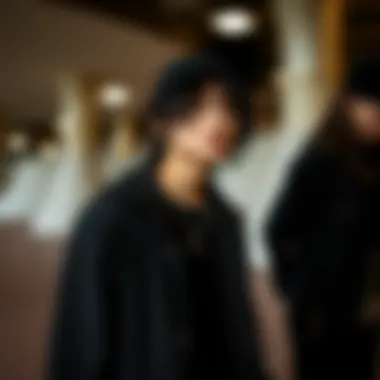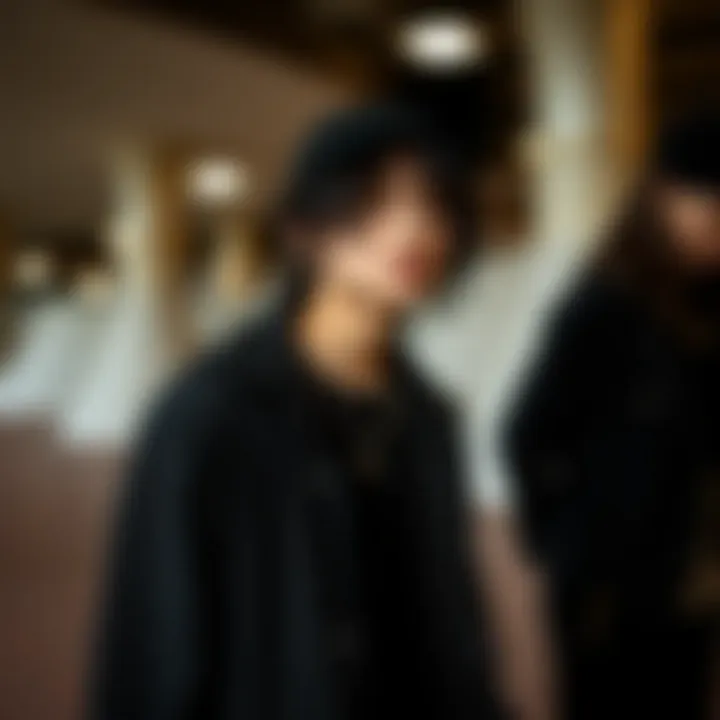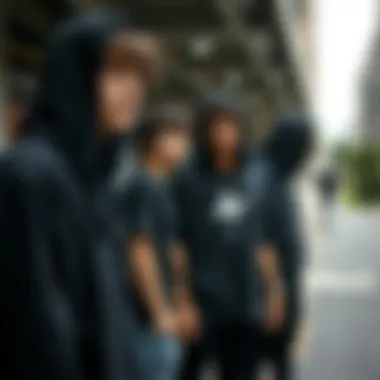Exploring the Impact of Black Clothing in Teen Fashion


Intro
In the realm of teen fashion, black clothing stands out as a timeless staple. Ranging from oversized hoodies to sleek skinny jeans, black garments hold a unique allure that transcends fleeting trends. For many teenagers, black is not just a color; it’s an assertion of identity, a comfort zone, and a canvas for self-expression. This article will explore how black clothes resonate deeply within the teen demographic, enriching their societal narrative and personal style.
By examining the psychological implications of wearing black, the versatility inherent in black apparel, and its predominance in alternative cultures like skateboarding, we can better understand its pervasive influence. Moreover, the role of social media and peer dynamics in teens’ fashion choices will be explored. Let’s dive into the heart of this phenomenon and uncover why black clothing has become a significant element in the wardrobes of youths today.
Understanding Teen Fashion Trends
Teen fashion is a dynamic and ever-evolving space where self-expression meets cultural currents. Understanding the trends that define it allows us to grasp how deeply intertwined clothing choices are with identity, social status, and emotional expression among adolescents. Teens often use fashion as a vehicle to communicate their individuality and affiliations, making it essential to look at the underlying forces that shape these trends.
Cultural Influences on Fashion
Cultural foundations play a significant role in shaping what teenagers choose to wear. From music playlists blasting at house parties to the latest viral dance challenges on social platforms, culture dictates fashion significantly.
- Music Genres: Take, for instance, the profound impact of genres like punk and hip-hop. The rebellious overtones of punk heavily influence the choice of black clothing, pushing the narrative of anti-establishment views through aesthetics. Artists like Billie Eilish and rappers such as Travis Scott pull teenagers toward darker, more edgy styles, paving the way for black clothing to dominate wardrobes.
- Pop Culture Phenomena: Furthermore, cinematic representations and TV shows have played a significant part. Think about the gothic undertones in shows like The Umbrella Academy, which portray characters that teenagers identify with, fostering an appreciation for black apparel as a form of belonging. Once seen as dreary, black now represents strength and self-assurance.
In essence, the cultural landscape cultivates an environment in which black clothing thrives, morphing to fit various socio-political narratives. This dynamic nature prompts teens to constantly engage with their attire.
The Role of Social Media
In the digital age, social media stands as a crucial player in the evolution of fashion trends. Platforms like Instagram, TikTok, and even Pinterest serve as visual highways leading to the latest styles, heavily influencing what teenagers see as fashionable. The exposure is not merely passive; it’s often interactive and trend-driven.
- Viral Trends: The influence of influencers cannot be overstated. As teenagers spend considerable time scrolling through their feeds, they are bombarded with styles worn by their favorite content creators. A simple trend like #AllBlackEverything can ignite a wildfire of similar posts among teens, and suddenly black clothes become all the rage, found on both high street and high-end retailers.
- Peer Influence: Social networks amplify peer influence. Friends share outfit ideas and pieces they’ve fallen in love with, creating a catalyst effect in which one teen’s choice to wear a black oversized hoodie inspires others to adopt similar styles. This interconnectedness has a snowball effect, making the appeal of black clothing multifaceted and widespread.
The marriage of fashion and social media has birthed a new society where clothing choices reflect both individual and collective identities.
"Fashion is a language that creates itself in clothes to interpret reality" — Karl Lagerfeld.
As we analyze teen fashion trends, we see black clothes rising to prominence due to these powerful cultural and social influences. They resonate within the psyche of youth, blending seamlessly with evolving identities, creative expressions, and shared experiences.
The Allure of Black Clothing
The appeal of black clothing can hardly be overstated when it comes to teen fashion. This fascination is not merely coincidental; it stems from a variety of psychological, cultural, and social influences that resonate deeply with the youth. Teenagers often view black as a canvas that allows for personal expression and individualism. It transcends trends, serving as a versatile choice that fits into multiple settings, from casual hangouts to more formal gatherings.
Psychological Aspects of Color
Color plays a fundamental role in shaping perceptions and emotions. Black, often associated with sophistication, elegance, and power, has a unique psychological effect on individuals. For teenagers, wearing black can provide a sense of security and confidence. Many find solace in this absence of color, which can sometimes feel less vulnerable compared to brighter shades.
Research suggests that black tones can influence moods and perceptions of identity. A study conducted by the University of California found that wearing darker clothing can elevate feelings of authority and strength among adolescents. This is particularly essential for teens who are navigating the challenging waters of self-esteem and social acceptance, as the choices they make in attire can significantly shape their interactions与others. Besides, black clothing can evoke a mysterious aura, often leading teens to feel more alluring in social settings. In a world filled with social media pressures, the psychological comfort of wearing black can be an empowering tool for many.
Symbolism of Black in Youth Culture
Black clothing occupies a vital space within different youth cultures. From punk rock to goth movements and even modern streetwear, it's hard to ignore the powerful symbolism of this shade. It signifies rebellion and non-conformity, often acting as a visual statement against mainstream trends. Teens who feel out of place in everyday scenarios may gravitate toward black as a symbol of strength and unity with others who share their alternative perspectives.
Moreover, black is a unifying color; it can foster connections among those who wear it. The black hoodie, for instance, is not just an item of clothing; it's a cultural emblem for many in the skate and streetwear communities. It represents not only individual style but also affiliation within subcultures, offering a sense of belonging.
"Black clothing serves as a canvas for youth to express their identity or affiliations and can offer a sense of empowerment in a society filled with pressure to fit in."
In summary, the allure of black clothing in teen fashion is rooted in its multifaceted symbolism and psychological effects. It seems to strike a chord between individuality and camaraderie, allowing teenagers to push boundaries on their own terms. Whether as a source of confidence or a statement of identity, black remains an essential element in shaping the modern youth wardrobe.
Black Clothes: A Staple in Skateboarding
Skateboarding isn’t just a sport; it’s a lifestyle deeply woven into the fabric of youth culture. Among the many threads in this tapestry, black clothing stands out as a prominent choice among skaters. Not only is it a fashion statement, but it also carries with it a series of advantages relating to functionality, self-expression, and identity within the skateboarding world.
Functionality and Durability
When it comes to skateboarding, clothing must endure rough falls, grinds, and the wear and tear that comes with the territory. Black clothes, often made from heavy-duty materials like denim or canvas, provide the strength required for both practice and performance.


- Resistance to Stains: Black is notorious for its ability to obscure dirt and scuff marks, a must-have for skaters who find themselves on the ground often.
- Comfort and Flexibility: Apparel, especially baggy pants and loose-fit shirts, allows for unhindered movement when pulling off tricks or just cruising around. This comfort is often enhanced by choosing fabrics that provide stretch and breathability.
- Versatility: Black clothing can be worn across various settings—from the skatepark to hanging out with friends—making it a practical choice. It’s easy to layer or mix-and-match with other pieces, lending a timeless aesthetic while keeping function in mind.
It’s not just utility that makes black clothes appealing. The style complements the often rebellious nature of skateboarding, aligning with its roots in counterculture movements which reject mainstream fashion sensibilities.
Influence of Skateboard Icons
The impact of influential skateboarders on fashion cannot be ignored. Iconic figures like Tony Hawk or Nyjah Huston have wielded significant influence over teen fashion trends, regularly showcasing their own style choices. Many of these skaters have been decked out in black during their careers, which has left a lasting impression on young fans and budding skaters.
- Brand Collaborations: With leading brands like Vans and Element often promoting black clothing, the associations drawn from these endorsements can make black apparel an aspirational choice.
- Celebrity Effect: Celebrities within the skateboarding community sport black clothing, which garners attention and prompts imitators. Teens are naturally drawn to emulate the style of their idols. For them, wearing similar attire might even embody a sense of connection and camaraderie with their skating heroes.
- Trendsetters: Communities on platforms like Instagram or TikTok showcase subcultures within skateboarding, where black attire is heavily favored. The visual nature of social media means that this trend gets rapidly adopted amongst teens looking to carve out their identity.
Ultimately, black clothing serves as a canvas for self-expression within the world of skateboarding. Those who choose to wear it convey a message of authenticity, rebellion, and a dedication to the culture of skateboarding. In many ways, black clothes are more than just fabric—they’re a badge of honor, threading together the spirit of youth who dare to push boundaries.
Styling Black Apparel for Teens
Black clothing stands out as a foundational element in the wardrobe of many teenagers today. Mastering the art of styling black apparel offers not just a way to express individuality but also a practical solution for creating versatile outfits that accommodate any occasion. The appeal of black lies in its simplicity—there's something about the color that evokes a sense of confidence while providing endless opportunities for personalization.
When teens delve into styling black apparel, they discover a myriad of benefits:
- Timeless Versatility: Black clothing can easily transition from casual outings to formal events. Teens can combine a black hoodie with jeans for a laid-back look or pair a black dress with statement accessories for a night out.
- Base for Layers: Black serves as a neutral canvas, making it perfect for layering. An ensemble can shift dramatically with the addition of a brightly colored jacket or patterned scarf, allowing for effortless adaptability to changing trends or personal moods.
- Mood and Sentiment: Clothing choices often mirror inner feelings. Black apparel can resonate with the teen’s state of mind, whether it’s a desire for introspection or a spirited sense of rebellion.
In the quest for self-expression, the black clothing palette serves as a trusted ally, inviting creativity and personal flair without overshadowing the individual.
Layering Techniques
Layering is an essential technique for styling black apparel, particularly for teens keen on achieving both functionality and aesthetic appeal. Understanding how to layer effectively can elevate any outfit from ordinary to chic.
Start with the basics:
- Base Layer: Choose a comfortable black t-shirt or tank top as your first layer. This sets the tone for the outfit, providing a clean slate.
- Mid Layer: A black denim jacket or cardigan can add warmth and texture. This layer also brings depth, especially when it includes interesting cuts or unique details like embroidery.
- Outer Layer: Consider a longer black trench coat for those cooler days. This not only offers protection against the elements but can also account for a dramatic flair when worn open.
Don’t forget about unexpected combinations!
- Mix Textures: Layering different fabrics can create visual interest. A chunky knit sweater paired with a sleek black faux leather skirt creates an effortlessly fashionable look.
- Play with Lengths: A cropped black top layered over a longer black tunic can make for a striking silhouette.
Pro tip: Keep a few accessories handy to sprinkle into your layered look, such as bands or necklaces that peek through the layers, ensuring continuity while maintaining excitement and intrigue.
Accessorizing with Black Clothing
Accessorizing black clothing effectively can either enhance the depth of an outfit or create a stark contrast that captures attention. Black is uniquely suited for bold accessory choices, making it easier for teens to explore their style.
- Statement Jewelry: Large earrings or chunky necklaces in metallic finishes can provide eye-catching accents. Gold or silver pops against black, drawing the gaze and adding a layer of sophistication.
- Vivid Scarves: Incorporating a colorful scarf not only adds warmth but also introduces an element of excitement. Don’t hesitate to mix patterns; a geometric print or floral design can step up the vitality of an all-black outfit.
- Footwear Matters: Shoes can transform an entire ensemble. A pair of bright sneakers can inject energy into subdued black counterparts. Conversely, sleek black boots can lend a refined edge.
"The right accessories can be the secret ingredient to turning heads, even in the simplest of outfits."
Lastly, consider bags as key players in accessorizing. A tote bag in a bold color can serve as a practical and stylish component, while a small crossbody bag offers a touch of casual elegance.
In summary, styling black apparel is not just about wearing a color, it’s about leveraging the nuances of fashion to communicate personality and mood. Through layering and thoughtful accessorizing, teens can elevate their style game, making black clothing a canvas for their creative expression.
Popularity of Black Clothing in Various Subcultures
Black clothing is not just a color choice; it serves as a powerful symbol across diverse subcultures. It’s incredible how this color transcends conventional boundaries and acts as a unifying thread among various groups, each wealthy with distinct identities. Understanding why this significance is so pronounced can provide profound insights into youth fashion narratives.
Several unique aspects make black clothing paramount in these subcultures. These include its versatility, aesthetic appeal, and deeper meanings within each group’s ethos. It reflects their struggles, aspirations, and sometimes even their defiance against mainstream ideals.
Goth and Alternative Styles
Goth culture, rooted in the music scene of the late 1970s and 1980s, embraces black clothing as a crucial part of its identity. The color black symbolizes a rejection of societal norms, an embrace of individuality, and a gothic romanticism. Often layered, flowing silhouettes in velvets, lace, and leathers create an ethereal presence that resonates with goth aesthetics.
Through black attire, goths communicate their belonging without uttering a single word. This speaks volumes about the power of fashion as a medium of expression. It’s more than just a fashion statement; it often reflects a lifestyle. For instance, black combat boots are often paired with flowing black skirts or tattered tees adorned with band logos, creating a gritty yet poetic ensemble.


"Fashion is a language that creates a voice without words."
Further, the goth subculture often embraces dark romanticism, a blend of 19th-century notions with modern interpretations. This desire for darker themes also manifests in accessories, such as silver jewelry with intricate designs, often showcasing bats or skulls. It’s not merely about wearing black; it’s about expressing an intricate emotional landscape that draws upon literature and music. These elements allow a profound personal interpretation of one’s identity.
Streetwear and Urban Influences
Streetwear, on the other hand, uses black clothing as a canvas for urban culture. Emerging from skateboarding and hip hop, this style has morphed into a globally influential movement. Brands like Supreme and Off-White have popularized black hoodies and tees as staples in streetwear. The beauty of black in this subculture lies in its practicality and readiness for customization.
Streetwear blends comfort with style, often utilizing fabrics like cotton or polyester for that perfect chill vibe. Black joggers matched with oversized graphic tees or sleek jackets create a look that's effortlessly stylish. This versatility allows teens to express their unique personalities without sacrificing comfort.
Moreover, the influence of social media platforms, especially Instagram and TikTok, cannot be overlooked. Here, influencers showcase their takes on black streetwear, enabling viral trends that spark massive followings and spur a continuous cycle of creativity.
In both goth and streetwear contexts, black clothing resonates deeply with the youth. It stands as a statement against the expected, an assertion of identity that echoes across mere fabric. The ability of black clothes to mold itself into different meanings—whether darkly romantic or urban casual—underscores the profoundness of this enduring color within various subcultures. Its presence not only embraces individuality but also builds communities who wear their beliefs right on their sleeves, quite literally.
As the dialogue continues about how youth express their identities, black clothing remains a steadfast choice, shaping and influenced by the ever-evolving tapestry of teen culture.
The Impact of Peer Perception on Fashion Choices
In the realm of teen fashion, the role of peer perception cannot be overlooked. Amid the ever-revolving door of trends and styles, impressions from friends and social circles significantly shape the choices that youths make. Wearing black clothing, in particular, emerges not just as a personal choice but as a response to collective norms and expectations among peers. This dynamic relationship between fashion and friendship can encourage conformity, while also providing room for self-expression.
Influence of Friendship Circles
Friendship circles often act as a kind of unwritten fashion law. When a teen sees their closest friends sporting certain black clothing styles, they may feel encouraged—if not compelled—to adopt similar pieces. This social influence is not merely incidental; it's deeply intertwined with feelings of belonging. When a group collectively endorses a style, like that of black hoodies or skinny jeans, its very existence becomes validated.
- Belonging and Identity: When teens wear what their friends wear, they often feel a renewed sense of belonging. This creates a bond where members of the group share not just experiences but also outward appearances that reflect their unified identity.
- Mutual Validation: The more a teenager sees their friends dressed in certain black garments, the more normalized those choices become. Even casual comments, like "Hey, I love that jacket!" can contribute to a peer's willingness to invest in similar attire.
This peer-driven approach to choosing black clothes gets magnified in group settings, like parties or school events. Teens want to fit in, and sometimes, dressing alike can serve as an invisible glue in maintaining friendships.
Conformity vs. Individuality
While conformity can foster unity within friendship groups, it can also pose a challenge for the individual. On one hand, some teenagers may thrive in the structured environment where wearing black becomes a communal statement. On the other hand, there might be a lingering sense of losing one's unique identity beneath a sea of similar outfits.
- Expression vs. Pressure: Many teens experience the tug-of-war between wanting to fit in and aspiring to express their individuality. This is particularly salient with black clothing, which can convey rebellion, sophistication, or even melancholy.
- Risk of Stereotyping: There’s a fine line where conformity can lead to stereotyping. For example, teens dressed entirely in black might be perceived as belonging to introverted or gothic subcultures. It’s important to recognize that black clothing is versatile and does not confine wearers to a single narrative.
"Fashion should be a form of self-expression, not a prison of peer conformity. Embracing one’s unique identity is how fashion truly shines."
Finding the balance between fitting in and standing out is crucial for personal growth. As teens navigate their formative years, the choices they make in what to wear—and specifically, how they embrace black clothing—speak volumes about their self-perception and their responses to social dynamics.
For more in-depth discussions about teen fashion and identity, feel free to explore articles on Wikipedia, or surf through discussions on platforms like Reddit.
Moreover, insights about generational fashion trends can be found on Britannica or Fashion Institute of Technology.
Maintaining and Caring for Black Clothes
Black clothing holds a special place in the hearts of teenagers, providing both a fashion statement and an avenue for self-expression. However, to keep those garments looking sharp and chic, proper maintenance is essential. Not only does good care prolong the life of the pieces, but it also ensures they retain their rich colors and stylish appeal, which is particularly important for creating a standout look. When a favorite black tee or pair of joggers starts to fade or wear down, it shifts from being a staple to an eyesore.
Taking the time to learn about the right ways to care for black clothes can make all the difference. Let’s unpack the best practices on washing and ironing, as well as what can be done to prevent fading and general wear.
Washing and Ironing Tips
Caring for black clothes begins with understanding how to wash and iron them correctly. Here are a few handy tips:
- Cold Water is Key: Always opt for cold water when washing black clothes. Hot water can shrink fabrics and fade colors. Plus, cold water is gentler on the fibers.
- Separate Loads: Avoid mixing dark clothes with whites or brights. Not only do darker colors need different washing temperatures, but this prevents dye transfer which could ruin that black outfit.
- Mild Detergent: Using a detergent specifically designed for dark fabrics can help maintain color. It's often formulated to reduce the fading effects of regular detergents.
- Air Dry if Possible: Prospective wear and tear increases when clothes are tossed in a dryer. Whenever you can, air dry your black attire. If you need to use a dryer, stick with a low heat setting and promptly remove the items once they're dry.
- Iron with Care: When it comes time to ironing, keep the iron on a lower setting and use a cloth over the black fabric to avoid directly exposing it to the heat. This helps to prevent shine or burn marks.
"Proper care transforms black clothing into investments that stand the test of time, ensuring they remain wardrobe staples."
Preventing Fading and Wear
To truly preserve the richness of black clothes, extra steps can be taken beyond just washing. Here are methods aimed at preventing fading and wear that every teenager should consider:


- Limit Sun Exposure: Black clothing is prone to fading in direct sunlight. When hanging clothes to dry or storing them, opt for shaded areas. The sun can rapidly bleach out vibrant colors.
- Use Fabric Spray: Spraying a fabric protector can create a barrier against spills and stains that are problematic. Look for sprays that are suitable for dark clothing to avoid discoloration.
- Storage Matters: Instead of folding, try hanging black clothes. When items are folded, creases can form that may cause premature wear—especially in areas that get a lot of movement.
- Dealing with Pilling: Keep an eye on pilling. Gently use a fabric shaver or lint roller to keep the fabric looking fresh. This tiny maintenance task can prevent bigger issues later on.
- Infrequent Washing: While it’s tempting to wash clothes after every wear, try to limit washing black garments unless necessary. Not only does this practice help maintain color integrity, but it also reduces wear on the fabric itself.
By paying attention to these maintenance and care tips, teens can ensure their black wardrobe pieces continue to make a statement while being a testament to their personal style. With a basic understanding of how to wash, iron, and maintain the vibrancy of black clothing, it’s easier for young fashionistas to express themselves without constantly replacing worn-out items.
Black Clothing as a Form of Self-Expression
In contemporary youth culture, black clothing serves more than just a practical purpose; it plays a pivotal role in self-expression among teenagers. Up to this point, we have explored various dimensions of black apparel, but viewing it through the lens of identity formation reveals some deeper insights about the choices teens make regarding their wardrobe. Black, as a color, brings a multitude of meanings and associations, often tied to individuality and rebellion. In a world of constant social pressures, wearing black can be seen as a shield—a way to assert one’s uniqueness while simultaneously fitting into a broader cultural narrative.
Fashion as Identity Formation
The teenage years often represent a journey of self-discovery, where individuals grapple with their identities in pursuit of acceptance and belonging. Black clothing becomes a vehicle through which youth can communicate aspects of their personalities that might otherwise remain hidden. For example, a teenager sporting a black oversized hoodie may be signaling comfort and nonchalance, while another donning a tailored black dress can exude confidence and sophistication.
Teens frequently look for ways to express their emotions, values, and even social critiques. Through fashion, they explore different facets of their identities. Here are a few dimensions to consider:
- Rebellion: Black clothing often embodies a spirit of defiance against norms and expectations, especially in school or at home. It can denote a rejection of societal pressures to conform to more colorful or traditional styles.
- Solidarity: Black apparel frequently reflects allegiance to specific movements or ideologies, from environmental concerns to anti-bullying campaigns.
- Comfort: The versatility of black clothing allows teens to blend comfort with aesthetic appeal. When they choose black, they can feel liberated in their choice while still adhering to stylistic standards.
"Fashion isn’t just what you wear; it’s who you are, and black gives me the freedom to express that."
— Anonymous teen fashion enthusiast
Fashion Choices in the Context of Youth Movements
Black clothing is not merely a personal choice; it can serve as a collective statement reflective of broader youth movements. Over the years, many subcultures have adopted black apparel as a hallmark of their ideals—be it punk, goth, or even streetwear. Each movement imbues black clothing with its own narrative, resulting in a rich tapestry of meanings. For teens, choosing to wear black can show alignment with these movements, fostering a sense of community and belonging.
- Punk and Goth Subcultures: These movements embraced black clothing as a rejection of mainstream culture. In punk, black leather and studded accessories express a raw energy against societal norms, while goth culture uses black to evoke mystery, emotion, and depth. Wearing black in these contexts signals intent and recognition.
- Black Lives Matter Movement: Many teens utilize black clothing as a form of solidarity with social movements. It serves as a canvas for political expression and advocacy, particularly regarding issues of race and justice. A simple black T-shirt or hoodie with a relevant slogan can communicate powerful messages while promoting awareness.
- Streetwear and Urban Culture: The crossover of black apparel in streetwear symbolizes a blend of practical aesthetics and cultural authenticity, promoting unity among diverse urban populations. When a teen dons a black oversized tee with a trendy logo, they're often tapping into something greater than themselves—the very heartbeat of city life.
In summary, black clothing provides teenagers with a multifaceted means of self-expression intertwined with cultural identity, societal critique, and movement solidarity. As youth navigate their worlds filled with uncertainty and change, black becomes a canvas upon which they paint their stories. This exploration of identity via attire is not only significant, but it also supports the idea that fashion facilitates the expression of one’s innermost feelings, connecting adolescents with each other and broader cultural narratives.
Choosing the Right Black Clothes
Navigating the vast landscape of black clothing can be as complex as threading a needle in the dark. Teens today have a unique relationship with their fashion choices, as clothing often reflects personal beliefs, moods and even social affiliations. Within this context, choosing the right black clothes is crucial—not just for style, but for conveying individuality and resonance with peer groups. The significance of black clothing lies not just in its visual appeal; it also plays a pivotal role in shaping one's identity, especially for teenagers who are still solidifying their sense of self.
Fabrics and Fit
The fabrics and fit of black clothing can make or break a teen’s wardrobe. Black is incredibly versatile, but the material often dictates how the outfit operates within various settings. For instance, fabrics like cotton or denim are favored for casual wear, providing comfort and ease of movement, essential for active lifestyles such as skateboarding or hanging out with friends. On the other hand, items crafted from more luxurious materials—like silk or wool—might be worn during special events, serving to elevate one's look without losing the inherent elegance associated with black.
When it comes to fit, it’s about consistency with personal comfort. A pair of baggy black trousers might work for some, whereas others may lean towards fitted skinny jeans. Understanding one’s body type and personal style preferences is key. Teens need to ask themselves: Do I want to flaunt my figure, or seek something more relaxed? This self-awareness will undoubtedly influence their choices. Shopping for the right fit means trying on outfits, stretching, and moving to ensure it aligns with comfort and functionality. Additionally, consulting trusted friends can help in finding a style that resonates well.
Where to Shop for Quality
Quality should never be sidelined in the quest for the perfect black outfit. Knowing where to shop can significantly impact both the style and durability of pieces. Thrift stores and consignment shops can be treasure troves for unique finds; it’s entirely possible to snag a vintage black leather jacket that adds character and stands out from the standard fare. Conversely, mainstream retailers like H&M or Zara often have quality lines dedicated to black clothing, where affordability meets trendiness.
For those looking to invest a bit more, brands like AllSaints or A.P.C. are recognized for their higher-quality black pieces, offering an investment that usually pays off in longevity.
Parents should also consider the value of quality, especially if their teen is in a growth phase. Investing in a few higher-quality black items can have longer-term benefits over continually buying cheap fast-fashion items that wear out quickly.
"Investing in quality black clothing is not just about fashion; it's about sustainability and making conscious decisions about what we wear."
Finding the right black clothes involves a blend of understanding fabric and fit, alongside smart shopping choices. A well-curated black wardrobe not only reflects current trends but enhances the overall wardrobe versatility, allowing teens to express themselves uniquely and authentically through their fashion choices.
The End: The Enduring Appeal of Black Clothes
The allure of black clothing among teens is a multifaceted phenomenon steeped in cultural meaning and emotional resonance. As the final section of this exploration, understanding why black remains a timeless choice can illuminate how fashion defines youth identity and expression. Black clothes are not merely garments; they embody a resilience and give voice to countless personalities, moods, and aspirations. In a world where youth often struggle to articulate their thoughts, donning black provides a versatile canvas for individual expression.
Summary of Key Points
To encapsulate the insights drawn throughout the article, several key points emerge:
- Cultural Significance: Black clothing intersects with various cultural movements, symbolizing rebellion, sophistication, and unity across different subcultures.
- Psychological Impact: The color black evokes powerful emotions, often associated with strength, elegance, and introspection. For teens, this identity formation can be particularly meaningful.
- Styling Versatility: Black apparel can suit myriad styles, from skate to alternative. The ability to layer and accessorize allows for a personal touch that caters to individualism.
- Peer Influence and Social Media: With powerful social dynamics at play, the popularity of influencers and peer circles can drive trends, making black a staple in youth wardrobes.
- Future of Trends: As fashion evolves, black will likely adapt while maintaining its venerable status, continuously attracting the attention of upcoming generations.
Future Trends in Teen Fashion
Looking ahead, the integration of black clothing into teen fashion seems poised for a dynamic future.
- Sustainability: As eco-consciousness permeates the fashion scene, many brands are leaning toward sustainable materials, including black fabrics sourced ethically. This could become a significant draw for the environmentally aware teen.
- Tech Influence: The emergence of smart textiles suggests a fresh avenue for black apparel. Imagine fabric that can change hue or pattern, adaptable to the wearer’s preferences—the future could see black becoming even more innovative.
- Globalization of Styles: With cultural exchange easier than ever via the Internet, the styles associated with the color black from various cultures may meld, creating a rich tapestry of influences.
In summary, the enduring appeal of black clothing among teens lies not just in its aesthetic value but also in its capacity to resonate deeply across cultural, emotional, and social landscapes. The threads of individuality woven through each black outfit tell a story—a story of the ever-evolving youth culture that forms its identity around this timeless hue.















